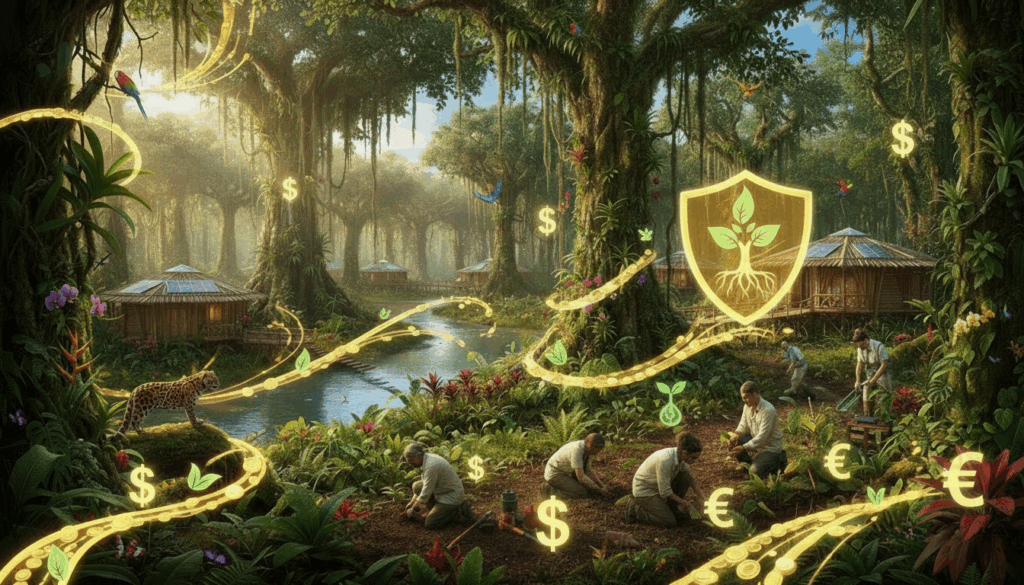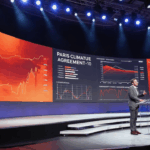As nature loss accelerates globally, biodiversity credits are emerging as a At COP30 in November 2025, Brazil unveiled one of the most ambitious—and controversial—climate finance mechanisms in recent memory. The Tropical Forest Forever Facility (TFFF) promises to channel up to $125 billion toward protecting the world’s rainforests, potentially rewarding up to 74 developing countries for keeping their forests standing. Billed as a game-changer for conservation finance, the fund represents a bold experiment in blending public commitments with private capital markets to address deforestation at scale.
Yet beneath the headline figure lies a complex financial architecture that has drawn sharp criticism from civil society organizations, Indigenous groups, and climate finance experts. Questions abound: Can a mechanism dependent on stock market returns reliably fund conservation? Does prioritizing investor protection over forest payments represent genuine climate action or financial innovation masquerading as environmental policy? And most fundamentally, will the TFFF actually help tackle climate change, or does it risk diverting attention and resources from more effective solutions?
As organizations navigate the evolving landscape of climate and biodiversity finance, understanding both the potential and the pitfalls of mechanisms like the TFFF becomes essential. This analysis examines the facility’s structure, assesses its promise against its limitations, and considers what it means for the future of forest conservation funding.
The Promise: Scaling Conservation Finance Through Market Mechanisms
The TFFF’s core innovation lies in its attempt to solve a persistent problem: how to generate sustained, large-scale funding for forest conservation without placing impossible demands on public budgets. The mechanism works by leveraging $25 billion in concessional capital from wealthy governments and philanthropies to attract $100 billion in private investment. Returns from this $125 billion portfolio would first repay investors, then compensate participating countries at approximately $4 per hectare of verified standing forest.
From a financial engineering perspective, the structure is elegant. By positioning donor capital as a buffer against losses, the facility offers institutional investors AAA-rated exposure to global bond markets while ostensibly serving conservation objectives. For comparison, the Green Climate Fund’s entire portfolio stands at roughly $18 billion—making the TFFF’s ambition truly unprecedented in multilateral environmental finance.
The fund also responds to a legitimate need. Tropical forests provide critical ecosystem services—carbon sequestration, biodiversity habitat, water cycle regulation, and livelihoods for millions—yet their value as standing forests rarely matches the economic returns from conversion to agriculture or logging. By creating a payment system that values intact forests, the TFFF aims to shift this calculus for landowners and governments across more than 1 billion hectares of tropical and subtropical forest.
Eligibility criteria establish clear performance metrics: countries must maintain deforestation rates below 0.5% of total forested area (averaged over three years) and demonstrate transparent financial management systems. Twenty percent of funds must be allocated to Indigenous peoples and traditional communities. These requirements, proponents argue, create accountability while recognizing the crucial stewardship role of local populations.
Moreover, the facility’s use of satellite monitoring promises transparent, verifiable measurement of forest cover—addressing a persistent challenge in conservation finance. In theory, this creates a “pay-for-performance” system where payments automatically adjust based on measurable outcomes, reducing the risk of funding ineffective programs.
The Problems: Financial Risk, Structural Inequity, and Questionable Assumptions
Despite its ambitions, the TFFF faces fundamental challenges that raise serious doubts about its viability and appropriateness as a climate solution.
Financial Architecture and Risk Allocation
The facility’s financial structure reveals a troubling hierarchy of priorities. Private investors occupy the “senior” position, protected first against losses. Sponsor governments receive their capital back over 40 years with interest. Only after satisfying these obligations do forest countries receive payments—and these payments depend entirely on investment returns.
This structure means conservation funding becomes hostage to market volatility. A debt crisis in emerging markets, sustained poor investment performance, or financial sector turbulence could “wipe out” sponsor capital and “halt rainforest flows, possibly before they even begin.” The countries providing the environmental service—forest conservation—bear the greatest risk while investors enjoy guaranteed protection from taxpayer-funded buffers.
The payment level itself raises questions. At $4 per hectare, the compensation may be insufficient to genuinely shift economic incentives away from deforestation, particularly where agriculture, logging, or mining offer substantially higher returns. As critics note, “$125 billion sounds much better than ‘we put $2.5 billion on the table conditionally'”—yet the actual resources reaching forest communities may be far less impressive once investor returns, management fees, and operational costs are deducted.
Fragmentation and Legitimacy Concerns
The TFFF operates outside all three Rio conventions (climate, biodiversity, land degradation), despite claiming to contribute to each. This positioning risks undermining already under-resourced multilateral mechanisms like the Green Climate Fund and Adaptation Fund, while avoiding the accountability frameworks built into these official channels. Stated differently: The facility risks not increasing total resources for climate and biodiversity finance, but rather fragmenting the funds already available. At a moment when developed countries face pressure to meet their obligations under the Paris Agreement and honor their commitments to climate-vulnerable nations, the TFFF potentially provides convenient cover for redirecting rather than supplementing existing finance flows.
The facility’s reliance on private capital also dilutes the principle that developed countries bear historical responsibility for climate change and owe climate finance as an obligation, not a favor. By framing forest payments as returns on investment rather than recognition of ecosystem services or compensation for conservation opportunity costs, the TFFF reinforces market-based approaches that may be fundamentally inadequate to the scale and urgency of the biodiversity and climate crises.
Governance, Transparency, and Indigenous Rights
Despite commitments to allocate 20% of funds to Indigenous peoples and local communities, decision-making power remains concentrated with governments and financial institutions. The Global Forest Coalition warns that Indigenous groups have “consultative roles” but lack genuine authority over fund governance—a significant concern given that these communities are often the most effective forest stewards.
Information on transparency mechanisms, corruption safeguards, and accountability structures remains sparse. Truth is some tropical forest countries have autocratic regimes and very limited civic space. This should raise serious questions about whether payments will genuinely support conservation or simply flow to governments with poor human rights records and limited accountability to forest-dependent populations.
The low threshold for what qualifies as “forest” (20-30% canopy cover) has also drawn scientific criticism for potentially allowing payments even where industrial logging occurs in primary forests. This suggests the facility may prioritize disbursement over genuine conservation outcomes, rewarding minimal compliance rather than ambitious protection.
Implications for Climate Action and Conservation Finance
The TFFF represents a broader trend in climate finance: the increasing reliance on financial engineering and private capital mobilization rather than direct public investment in climate solutions. While innovation in conservation funding deserves exploration, the facility’s structure reveals concerning priorities.
The mechanism essentially asks forest countries and communities to provide continued environmental stewardship without payment certainty, while guaranteeing returns to investors and capital recovery for donors. This inverts the logic of ecosystem service compensation and suggests that the primary objective may be creating attractive investment vehicles rather than ensuring effective conservation.
Furthermore, the facility does not address root drivers of deforestation: global commodity chains, consumption patterns in wealthy countries, agricultural subsidies that incentivize land conversion, or the power imbalances that enable resource extraction from tropical forest regions. From this perspective, TFFF may be regarded as a distraction that diverts attention and resources from real solutions like regulation, corporate accountability and direct financing for Indigenous and local initiatives.
The modest funding commitment thus far—Brazil’s $1 billion pledge and finance minister Fernando Haddad’s revised expectation of raising $10 billion by 2026 (less than half the original $25 billion target)—suggests that even sponsor countries may be skeptical of the facility’s viability. The UK’s reported withdrawal following treasury concerns about affordability amid rising debt burdens further indicates that the mechanism may struggle to achieve its ambitious fundraising goals.
Conclusion
Brazil’s Tropical Forest Forever Facility emerges from genuine concern about forest loss and the inadequacy of current conservation finance. Its scale of ambition deserves acknowledgment, as does Brazil’s attempt to center tropical forest protection in global climate discussions. Yet the facility’s fundamental architecture—prioritizing financial market logic over conservation outcomes, protecting investors over forest communities, and operating outside established multilateral frameworks—raises profound questions about whether it represents genuine progress or a dangerous distraction.
The climate and biodiversity crises demand urgent, scaled responses. Forest conservation is undeniably central to both challenges. But solutions must be judged not by the impressiveness of headline figures but by their likelihood of achieving real-world outcomes, their equity in distributing costs and benefits, and their coherence with broader climate justice principles.
Organizations and governments seeking to support forest conservation should scrutinize whether mechanisms like the TFFF genuinely advance these goals or whether they primarily serve to create palatable investment opportunities that avoid confronting the systemic changes actually required. The complexity of the TFFF’s financial structure, the conditionality of its payments, and the hierarchy of its risk allocation all warrant careful analysis.
Navigating the evolving landscape of climate and biodiversity finance requires sophisticated understanding of both environmental imperatives and financial mechanisms. At Ksapa, we bring 25+ years of experience helping organizations assess sustainability initiatives, structure impact investments, and develop strategies that align financial returns with genuine environmental and social outcomes. Whether you’re evaluating participation in emerging facilities like the TFFF, developing conservation finance strategies, or seeking to structure investments that deliver measurable impact, our team combines deep technical expertise with practical implementation knowledge. Contact us to discuss how we can support your organization in making informed decisions about climate finance, forest conservation investments, and sustainable development strategies that withstand critical scrutiny and deliver lasting results.
Credit: Freepik
Author of several books and resources on business, sustainability and responsibility. Working with top decision makers pursuing transformational changes for their organizations, leaders and industries. Working with executives improving resilience and competitiveness of their company and products given their climate and human right business agendas. Connect with Farid Baddache on Twitter at @Fbaddache.






